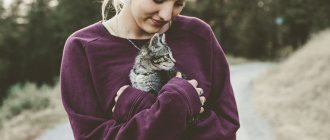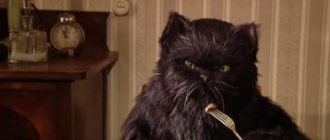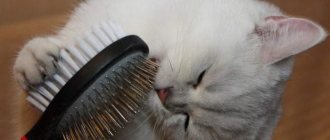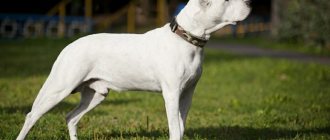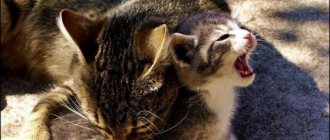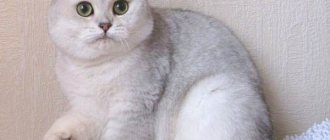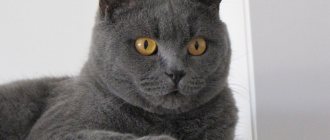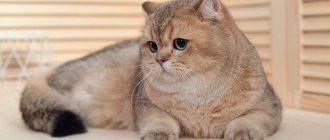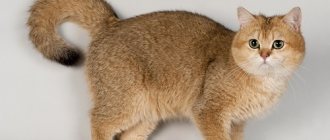A person who keeps pets gets sick 5 times less than other people. Whether the information is true or just speculation from pet lovers is unknown. But there is no doubt that the appearance of a British chinchilla cat will have a beneficial effect on the mood of all family members. The appearance, color of the plush beauty, character, habits, everything speaks about the difficult origin of the pet.
Characteristics of the British chinchilla - character and behavior
Speaking about the characteristics of the breed, it’s worth saying right away that the British chinchilla is an aristocrat among cats. She quickly and easily gets used to her owner and his family, feeling like a full-fledged member of society. But at the same time, the cat avoids excessive displays of feelings, preferring to love everyone in silence. In addition, she does not like excessive attention - if you pet your pet too actively or hug him too much, the British chinchilla will get up and go to a quieter place. Because of this, they are perceived as cold and unfriendly animals.
Kittens quickly learn the rules of living in a family if they are clear and well formulated. They will never crap past the litter box, climb onto the bed, or steal food from the table, but to do this, the owner must immediately confront the pet with these facts and be adamant. You should not hope that after the cat has slept on the owner’s pillows several times and has not been punished for it, he will give up this pleasant habit.
It’s nice that even in a small apartment, a Briton will not cause unnecessary problems for the owners. They don’t rush around the rooms like crazy and don’t wake up the owner with howls if at three o’clock in the morning they suddenly want a snack and the cup is empty. Therefore, if you love cats, it will be difficult to find a better pet than the British chinchilla.
Education and training
Chinchillas need to be raised and trained using the same methods as all cats, but taking into account the individual characteristics of each breed. Mandatory skills and abilities that the animal must master by the age of one year:
- the ability to respond to one’s own nickname;
- go to the toilet and sharpen your claws in a strictly designated place;
- observe the sleeping and feeding schedule, do not wake the owner at night;
- sit calmly in the owner's arms;
- adequately perceive the need for transportation: traveling in a carrier bag, traveling by car.
Owners of show pets will also have to work on the technique of displaying the animal at an exhibition. Since both the British, the Persians, and the Scottish have a compact body, in the ring they are not exhibited “stretched” like Orientals, but in a grouped state. Preparation for this action is considered to be the development in the cat of the habit of sitting on the laps and hands of the owner, as well as patiently accepting changes in posture at the insistence of the person.
Persian chinchillas are intelligent and highly intelligent cats, grasping basic cat wisdom on the fly. For example, by 1-1.5 months, kittens go to the litter tray quite carefully. Often, if babies live with their mother or another adult cat, they don’t even need to be taught this skill - the furballs independently copy the behavior of the older pet.
Young and even slightly mature chinchillopers retain a lively interest and curiosity in things they see for the first time, so at first you will have to hide indoor plants, toxic detergents and cleaners, as well as the wires of household appliances from the animal. The breed does not produce any destructive actions - chinchillas do not scratch furniture (provided that there is a normal scratching post in the house), they do not rummage through the owner’s plates, and they do not take away piece by piece a newspaper forgotten by the bed.
At the beginning of socialization, it is important for a kitten in a new home to create a peaceful atmosphere, so try to make less noise in the presence of the baby and warn your household about this. Classes should be carried out taking into account the chinchilla’s biorhythms: in the mornings and afternoons, cats are inactive and prefer to take a nap. And of course, keep in mind that not a single pet is capable of multitasking, so if you decide to practice one command, finish what you started without switching to teaching your furry other useful skills.
Chinchillas from the British and Scottish clans are hampered in their studies by natural shyness and timidity. These comrades are generally frightened by everything new and unknown, so during lessons, talk more with your pet in an even, calm voice. A chinchilla doing dirty tricks is such a rare phenomenon that not every owner of the breed manages to see it. If, nevertheless, the pet is drawn to the “scratchers” or the dining table, influence the animal with its own fears. Suddenly clap your hands or secretly splash water on the furry criminal - then you can only watch how the chinchilla coward quickly runs away from the crime scene, turning into a quiet good boy.
Description of the breed - what does a British chinchilla cat look like?
When choosing a suitable pet, it is advisable to take into account not only the character, but also the external description. On the one hand, this allows you to make sure that this breed will be a good choice. On the other hand, it reduces the risk of acquiring a purebred cat with defects. Therefore, this point should be described in more detail.
Appearance
The head of the British chinchilla is wide, massive and at the same time almost round. The transition of the forehead to the muzzle is clear and pronounced when viewed from the side. The skull is strong and has smooth, rounded contours. The forehead should be convex - a flat one is considered a gross defect. The cheeks are also rounded and full, making the pet’s face look elegant and cute. Wide cheekbones further round the head visually.
The nose is wide, but short and straight. The length is most often average. Strong, well developed chin. The ears are set wide apart and are of medium size. They are wide at the base and gradually taper towards the tips to end in a graceful curve. Large, almost round eyes are set wide. Eye color depends on the main color – we’ll talk about this a little later. But it must be rich.
The body can be either large or medium. The muscles are well developed, the physique is strong. The back is straight. The chest is strong and deep, smoothly flowing into broad shoulders. Body of medium length, stocky. The tail is thick at the very base, but tapers neatly towards the tip. The length of the tail is 70% of the length of the body.
Size
The British Chinchilla has a height at the withers of about 35 cm. And a strong physique gives the cat solidity and confidence.
Weight
Thanks to their powerful build, British chinchillas weigh a lot. Typically, adult cats reach a weight of 5-8 kg, and among sterilized cats living in small apartments, and even eating well, it is not uncommon for an indicator of 10-12 kilograms. Cats are noticeably smaller than cats - they usually weigh only 3-4 kilograms. True, if your pet is sterilized, she will actively gain additional weight and can reach 6-7 kilograms.
Wool
The wool is plush and moderately soft. Not too long, but at the same time longer than short-haired breeds. Pleasant to the touch, with a delicate texture. Doesn't fit tightly to the body. The undercoat is abundant and pronounced. Both too coarse and too soft wool are not allowed - here connoisseurs of the British chinchilla have strict requirements. A long-haired chinchilla is also likely to be rejected at the show.
Colors
Chinchilla color comes in two varieties: tipped and shading. In the first option, the wool is partially colored - the base remains white, and the very tips, about 1/8 of the length, are colored the main color.
Shading or shaded is a little different. The wool is also partially dyed, but more intensely - the hair is dyed about a third of the length.
The breed standard allows for many color options. The main ones include:
- White wool,
- blue (and also blue gold),
- redhead,
- black,
- gray,
- gold (or, as an option, golden - according to the standard marking BRI NY 12),
- silver
But a marbled cat or a representative of the breed with a point color is definitely considered a defect - such colors are not found in purebred British chinchillas.
Colors of chinchilla cats
All three varieties of chinchillas have very complex color palettes. In general, we can say that animal fur comes in three basic shades:
- silver;
- golden;
- shaded.
Silver individuals are cats with white fur, which has a barely noticeable “spraying” of dark pigment at the very tip of the hair. No spots or extraneous patterns on the body are allowed, but it is imperative that the chest remain white. There are also veil and shaded varieties of silver color. In the first case, a dark “patina” on the wool creates the effect of a veil or organza, slightly darkening the light background of the “fur coat”.
An interesting fact: kittens with a veil color are born only when both parents are carriers of the same color.
Shaded Silver is a completely white undercoat and guard hair, ⅓ of which is dark in tone. The most intense colors of shaded chinchillas are the head, back, ears and tail. The collar area has a classic silver color, and completely dark hairs can appear on the paws and tail.
The palette of chinchilla veil and shading pigments is quite extensive. In particular, the tips of animal hairs can be colored in the following shades:
- chocolate;
- cinnamon;
- faun;
- blue;
- lilac;
- black.
An important nuance: chinchillas in veil-type “fur coats” with black hair pigmentation should have black eye rims bordered by white hair, as well as black paw pads.
The golden color of chinchillas is not identical to the red one. It's more of a soft apricot shade. Individuals with golden veiled “coats” are pets in which the pigment appears only at the very tip of the hair and only in certain areas. The most pigmented parts of the body are the back, ears, head, and tail. On the sides the “veil” noticeably thins and completely disappears closer to the stomach. The shaded golden coat is colored in dark tones for ⅓ of its length. More intensely pigmented areas are the back and head of the animal. The collar area remains white.
Are British Chinchilla cats hypoallergenic or not? How often do they shed?
Cats of this breed shed twice a year - in the off-season, replacing summer coat with winter coat and vice versa. At this time, they need special care - they will have to be combed three to four times a week, or better yet, every day. But even with this there will be a lot of wool. And the rest of the time, molting occurs constantly, although not so intensely.
The British chinchilla is not hypoallergenic. If there are people in the family who suffer from allergies to cat fur, then you definitely shouldn’t get a British chinchilla.
GALLERY OF PHOTO BRITISH CHINCHILLAS: BRITISH CATS, CATS, KITTENS SILVER AND GOLDEN CHINCHILLAS
The gallery presents British chinchillas:
- photos of silver British cats, cats, kittens;
- Photos of golden British cats, cats, kittens.
All British chinchillas meet the standard and have the correct color.
| In our cattery you can “buy a real British kitten.” We have many different colors, we will help you choose and answer all your questions! |
Is the British Chinchilla a friendly breed?
There is an opinion among some animal lovers that this breed is not very friendly. Allegedly, she does not like affection and tries to stay away from people who often pet her.
Actually this is not true. The British chinchilla, like any other cat, loves affection. She loves to lie on her owner's lap while he affectionately scratches behind the ear.
But at the same time, she has an aristocratic measure of intimacy. When petted, the pet purrs happily. But if you cross a certain line - forcefully hold him on your knees, hold him tightly to you, or press hard while stroking him, the Briton will definitely not tolerate this and will try to sneak away. Therefore, when getting a cat of this breed, be prepared for the fact that she will respect you if you are ready to treat her with respect.
Health
British chinchillas are distinguished by good health. These are hardy animals that are not afraid of frost and wind. Warm and thick wool reliably protects pets from the vagaries of the weather. But it’s better not to take your fluffy for a walk in the rain or slush.
Like all cats, chinchillas suffer from kidney disease. Bring your pet to the veterinarian periodically to detect pathology at an early stage.
The British have watery eyes, and this is taken into account when purchasing a kitten, since the eyes will require care.
Attitude towards children
Almost always, British chinchillas have a peaceful relationship with children. They are smart enough to forgive human kittens some mistakes. Therefore, if they try to pull the tail or lift it, awkwardly grabbing the stomach, the cat will probably not use its teeth or claws. Instead, he will hastily, but with a certain grace, retreat to a place that is inaccessible to children. The main thing is to teach the latter that the pet has a certain place where he can be alone - for example, a box or a cat house. Now, if an overly intrusive child tries to pull the cat out of the shelter, which she is accustomed to consider inviolable, there is already a possibility of conflict. But in general, the British chinchilla is not at all predisposed to aggression.
Relationship with the owner
Cats quickly find a common language with their owner and play with children. The British are prone to apathy. The chinchilla cat loves to be given attention and entertained.
If the owner is busy and cannot pay attention to the golden or silver chinchilla, it becomes offended and begins to get bored. The animal loves to be nearby when the owner is reading a book, watching TV, or doing homework. He will sit in your arms exactly as long as he wants.
The cat is imposing, allows itself to be stroked and scratched behind the ears. But he does not tolerate familiarity. As soon as the owner begins to squeeze the cat or tries to pat it, the pet expresses dissatisfaction. They are the kind of animals that allow themselves to be loved and set their own rules.
Attitude towards other animals
How relationships with other pets will develop depends solely on their behavior. The British chinchilla does not have a tendency to conflict. However, this aristocrat will not tolerate infringement of his rights. Relationships with large dogs are friendly. A cat and a dog can become friends - sleep together, eat from the same bowl. With small dogs that bark a lot and often try to assert themselves at the expense of others, relationships will most likely be strained, and there is even the possibility of conflicts.
British chinchillas are reserved with cats, but, as a rule, they do not show excessive affection. Relations are calm, even, but not too friendly. Although, if the neighbors try to dominate and oppress a native of Britain, things may end in a fight.
British chinchillas will not make friends with small rodents, such as rats, mice or hamsters - they are perceived exclusively as potential prey. Therefore, it is better not to leave your pets alone, at least if the lives of small animals are not protected by the glass of the aquarium or the metal bars of the cage.
Castration and sterilization
Animals with genetic pathologies that do not correspond to one degree or another to the breed standard are not allowed to be bred. Such pets are spayed or neutered to avoid unwanted offspring and diseases of the reproductive organs.
British chinchillas are operated on at 8–10 months of age, when the body is already strong and mature, but sexual behavior has not yet manifested itself.
Playfulness
What British chinchillas love is to play. Seeing a thread with a bow at the end or another toy, they instantly forget about their solidity, sophistication and aristocratic manners. There is only a cat and his toy. Even older animals, not to mention kittens, are ready to chase a target for a long time, catching it, throwing it, temporarily releasing it and attacking again. Playing together will give a lot of pleasure to both the owner and the pet.
But this can also be called a disadvantage. You need to regularly spend at least a little time playing with your cat. Otherwise, the relationship may deteriorate - the cat will no longer perceive the owner as a close friend. And lack of mobility often leads to excess weight gain, which affects the well-being and health of the pet.
Therefore, it is best to get British chinchillas for large families with many children who are ready to regularly find time to play with their favorite pet.
Maintenance and care
They feel great in apartments, tangles rarely appear on the coat, and there is no need to comb them regularly. The teeth are examined, sometimes suppuration appears in the eyes due to the peculiarities of the formation of the tear ducts. To keep their fur shiny and beautiful, they are bathed using cat shampoo. A scratching post is used to trim nails; toys help maintain muscle tone.
Good health and strong nerves are transmitted through genes, but chinchillas sometimes develop the following diseases:
- Hypertrophied cardiomyopathy.
- Destruction of the retina.
- Polycystic kidney disease.
They are given food in moderation, the British quickly gain weight, develop diseases, diabetes, liver damage, and die faster. Worms are regularly removed and the following vaccinations are given:
- From rabies.
- Plagues.
- Calcivirosis.
- Rhinotracheitis.
Cats are distinguished by their intelligence, noble character traits, calmness, and get along well with children and other pets.
The following equipment is purchased for maintenance:
- Tray and granular filler.
- Container for food and water.
- Scratching post.
- Claw clipper.
- Comb.
- Several toys.
Purebred animals consume high quality food; poor food has a negative impact on their appearance.
At exhibitions, owners choose kittens for themselves, meet breeders, receive instructions on how to care for their pets, and learn about the cat’s character traits and morals. Only experienced breeders with a good reputation buy animals to attend exhibitions. There is always a chance to acquire individuals with breed defects who will not be able to win anything. Breeders show the conditions in which the young animals live and provide information about the health status of the parents. Before contacting kittens, hands must be disinfected.
Pets are sold when they are 3 months old, all documents are drawn up, and their pedigree is indicated. When purchasing, an agreement is concluded that specifies the actions of the parties in different circumstances. A purebred British chinchilla costs between $400 and $600.
Holistic foods contain a full range of vitamins. When using natural food, the basis of the diet includes proteins, fish or chicken, liver, heart, and other offal is boiled. Fermented milk products are dosed in moderation, oils, fats and grains are consumed regularly.
Living in an enclosed space does not cause them discomfort, they shed little and do not leave fur everywhere. For independent pets, a separate corner is created in the apartment that belongs only to them.
How to cope with loneliness
An important advantage of the breed is the ability to enjoy not only a large company, but also loneliness. Yes, if you leave your pet alone for the whole day, you don’t have to worry that he will tear the upholstery on the sofa, knock over a flower and turn important documents into confetti. The British chinchilla calmly accepts loneliness and will take advantage of the free time to clean itself up, get a good night's sleep, sit on the window, calmly watching what is happening in the yard. In a word, an ideal pet for people with irregular work schedules.
Appearance
The color of British chinchillas can be different, among the main and generally accepted ones are:
- Classic silver.
- Gold.
- Cream.
- Ticked (or smoked).
- Smoky.
There are also quite interesting coat colors of British fur coats that are gaining popularity:
- Tortoiseshell (distinguished by a special variety of colors, patterns and shades).
- Bicolor (white color looks impressive in combination with an alternative color).
- Tabby.
- Marble (today one of the most expensive colors).
- Harlequin (“mask” or “tie” of an alternative color).
- Cinnamon and Faun.
The pride of English chinchillas is their beautiful emerald eyes. According to the criteria of international exhibitions, cats of this breed can also be yellow, but only in combination with black or dark smoky color. Almost all chinchillas have dark eye contours, which gives them even more expressiveness.
The light coat color of representatives of this cat breed is usually combined with dark (black, dark purple and gray, the lilac Briton looks especially beautiful) paw pads and nose.
In golden British chinchillas, not all of their coats are colored gold. The back, sides, and tail are somewhat darker than the main color, and the tip of the chin, neck and belly are peach.
British chinchillas have remarkably well-developed muscles and a fairly strong, wide neck. Representatives of this breed have a straight back of medium length, and the chest is also well built. Chinchillas have powerful paws and rounded hips. In addition, these cats have a thick tail with a curve at the very tip.
Males have very large and round cheeks, which make them very easy to recognize. And the main treasure of British chinchillas is their large, expressive, round-shaped eyes. They are planted not very deeply at a short distance from each other.
Potential Health Problems
The health of the representatives of the breed is excellent - many decades of selection have not been in vain, experts tried to select the strongest and healthiest animals for breeding.
In fact, the only health problem is a predisposition to allergies. Therefore, only proven and high-quality food should be given, and new components should be introduced into the diet gradually, carefully monitoring the animal’s well-being. Spoiled or unsuitable food affects the entire gastrointestinal tract. In the most advanced cases, this leads to liver disease and diabetes.
In some cases, although less frequently, problems with the eyes (retinal atrophy) and the cardiovascular system occur. Therefore, it is important to ensure that older cats do not run around a lot - they need enough rest and it is not advisable to disturb them at this time.
Obesity may also occur. But only in cases where the owner feeds the pet uncontrollably and with inappropriate food. Gaining excess weight is dangerous; it often leads to the development of a whole range of serious diseases that shorten life. So, it is important to ensure that the cat eats not only high-quality food, but also in sufficient and not excessive quantities. Then the pet will live a long life and even in old age will be cheerful, active and cheerful.
Chinchilla health and diseases
The main problems of Persian chinchillas are uncontrollable lacrimation and susceptibility to colds. The latter phenomenon is directly related to the structural features of the animal’s skull. All chinchillopers have been diagnosed with a slight curvature of the nasal septum, due to which even a slight runny nose is more difficult for them than for other cats.
British and Scottish Straight chinchillas do not have genetic diseases. At the same time, representatives of these families easily catch various infections, the salvation from which will be timely vaccination. Cats are also prone to gaining extra pounds, so when creating a diet, you will have to constantly keep your finger on the pulse.
Scottish Fold chinchillas are not as big as Straights. In particular, Scottish Folds exhibit a genetic disease such as osteochondrodysplasia. The disease is provoked by the gene responsible for the drooping shape of the animal’s ear, so it will not be possible to prevent it even if one wants to.
Cost of kittens
The price for a pet-class kitten will be 5-10 thousand rubles. The standard price for a breed-class cat varies between 20-30 thousand rubles. But if you dream of owning an elite show-class British dog, capable of taking first places at exhibitions and whose kittens will be lined up with connoisseurs, then the price will range from 50 to 100 thousand rubles. The specific amount depends on which nursery you will buy it from and how famous and titled its parents are.
British chinchilla nurseries
It is reasonable to adopt a purebred cat from a nursery. In Russia, the British chinchilla is a popular breed and there are many nurseries breeding them. Here are some of them:
- in Moscow: An Marion, Raylis, AppleWood;
- in St. Petersburg: Muslin Cats;
- in Nizhny Novgorod: Emirrian cattery;
- in Yekaterinburg: Silver Shine.
Of course, this is not a complete list of nurseries in Russia. Surely every animal lover can easily find a suitable one near the place where he lives.
Purchasing a British Golden Chinchilla kitten
Purchasing purebred British chinchilla kittens is not easy. It is better to choose purebred representatives in trusted nurseries or by contacting reliable breeders who breed this particular breed.
Attention! When purchasing an animal on the market or through a private advertisement, there is a high risk of being deceived and becoming the owner of an ordinary kitten with an unusual color.
Criterias of choice
When choosing a British chinchilla kitten, you should consider a number of recommendations:
- Carefully study the breed standard.
- Make a list of breeders and nurseries. Study reviews about them, become familiar with the peculiarities of keeping animals.
- Be sure to look at the kittens' parents, taking into account their compliance with the breed standard. The breeder will certainly provide a pedigree confirming the purebred of the sires up to the 4th generation.
The immediate choice of a kitten should be approached by paying attention to some features:
- Behavior. When a kitten sees a stranger, it should not try to hide in a corner in horror. A healthy baby is cheerful and inquisitive.
- Appearance. The kittens' coat should be shiny, their eyes and ears should be clean, and their nose should be moist.
- Relevant documents: metrics, pedigree, veterinary book, etc.
At what age is it better to adopt a kitten?
Conscientious breeders hand over kittens to new owners no earlier than 3 months . Babies of this age can already feed themselves and are also trained to use a tray.
Need for care
When getting a British chinchilla, it is important to remember that these cats love an active lifestyle. Therefore, it is advisable to walk them at least once or twice a week. To do this, you should use a harness with a roulette leash. They are smart enough not to run away from their owner. But if the cat is scared, it may climb a tree, get hit by a car, or run away.
Don't forget about regular brushing. And although these cats do not have a tendency to form tangles, you will have to comb your pet at least once or twice a week - without this, hair will be everywhere.
We must not forget about regular care. Check and clean your ears and teeth every week. Monitor the condition of the claws - if your pet does not have a scratching post on which he can grind his claws, then they will have to be trimmed once or twice a month.
Finally, it is advisable to bathe the cat approximately once every two months, using a special shampoo that gives the coat a beautiful shine and volume.
Varieties of color
Felinologists first divided the visual metallic background into two categories: chinchilla and shaded (darker) chinchilla. In the 70s, British shorthairs and exotics came to the attention of breeders.
In order not to confuse them with Persians, they came up with a new name for the color - ticked. Later, this division was abandoned, the Persian cat returned its generic name, and the term “chinchilla” began to mean only color.
Silver cats
The base of the hair is slightly colored or remains white altogether. Gene I (inhibitor) is responsible for this. The more actively it works, the less pigment on the hairs. An ideal chinchilla cat has only 1/8 of its hair length colored.
Golden
A similar situation occurs in the group of golden ones - the faster the I-gene begins to act, the more spectacular the chinchilla’s coat looks.
The difference between silver and gold is the division of all cats into black and red (red). It is the main color that influences the shade and creates the signature chinchilla shimmer.
The specific distribution of species occurs due to the level of pigmentation of the hair.
- 1/8 to 7/8 – natural chinchilla;
- 50/50 – shaded color;
- 7/8 to 1/8 – smoky.
The very genetic distribution of hereditary instructions and even the list of genes that take part in the process still remains a mystery. Some cat breeders believe that only animals from the black group can be golden, while others oppose them and give examples from breeding.
Other chinchilla colors
From time to time, announcements of new shades of color appear. The Scottish chinchilla cat gave a litter of blue tones, which immediately became a sensation among lovers. But later this trait was not inherited.
- In the black series of chinchilla cats of the British breed, blue, lilac and chocolate colors are experimented with.
- A Scottish chinchilla kitten from the red group seemed to have acquired a stable cream color, but after a few months it changed colors and lost its uniqueness.
This is interesting! New breeding groups are constantly being included in the selection, so breeders will definitely find a solution to maintain a stable balance of colors through experience.
Maintenance cost
As we have already found out, the cost of a purebred kitten is high. But after the purchase, the expenses do not end at all. The cat needs to be provided with suitable care. In this case, she will look and feel healthy and live a happy and long life. There are no trifles here and cannot be. Therefore, let's study the main expense items.
Nutrition
The main and most important expense item is the purchase of feed. The owner himself must decide what he will feed the pet - dry food or natural food. Both options are good. The first one saves time, and the second one saves money. However, when feeding dry food, you need to make sure that the cat always has access to fresh, clean water. Otherwise, there is a risk that she will become dehydrated, and this is a direct path to kidney disease.
You need to approach the choice of food responsibly. Cheap food made mainly from soy products should never be used. A cat is a predator that must receive animal proteins, not plant proteins, which are poorly digested. Therefore, make sure that the food contains at least 40% natural proteins (meat, fish, offal), or more. The cost of quality feed starts from 500-700 rubles per kilogram. The approximate portion for an adult is 12 grams per kilogram of live weight. Therefore, with a weight of 3-8 kilograms per month, you will have to spend about 500-2000 rubles on feeding your pet.
When choosing food for kittens, it is important to ensure that the kitten can chew the kibble normally. If they are too large, then the tiny jaws will not be able to handle them and the pet will be constantly hungry. It is advisable to take special food for kittens.
Some owners prefer to feed their pet natural food. Vegetables and fruits are practically not needed, but if your pet likes to feast on them, then you can give them. The main thing is that they make up no more than 40% of the diet, and preferably less. The main diet consists exclusively of animal products - after all, a cat is a predator by nature. Your best bet is lean meat such as beef, poultry and rabbit. Three to four times a week you can give sea fish, after removing large bones. If there is none, it can be replaced with river water, but carefully boiled so that the cat does not become infected with worms. A third of the diet should be diversified with offal products - heart, kidneys and liver. On the one hand, this makes food cheaper. On the other hand, offal contains many microelements and vitamins that are not found in meat. Therefore, they are needed for a balanced diet.
But you need to be careful with milk. Yes, kittens eat it with pleasure. In adult cats and kittens, it can cause stomach upset. To prevent this from happening, you should replace milk with low-fat kefir or fermented baked milk. British chinchillas eat them with pleasure, receiving calcium and other necessary substances.
Veterinary
It was said above that British chinchillas get sick relatively rarely. But this does not mean that visits to the veterinarian can be ignored. No, any disease is easier to cure in the initial stages than when it is advanced. Or better yet, prevent it.
Therefore, you need to visit the veterinary clinic regularly: annually for young and adult cats and twice a year for older cats. The initial visit costs approximately 500-600 rubles, and subsequent ones - 300-400.
If a disease is detected, the cost of treatment varies greatly - there are many nuances that will have to be dealt with depending on the situation.
Exhibitions
Cat shows are rarely free. There is almost always a certain participation fee. And its size varies - from several hundred rubles to several thousand. This depends on several factors: the prestige of the club, the fame of the invited judges, prizes, etc.
In addition, you will have to spend money on grooming, a handler, travel and accommodation (if the exhibition is held in another city).
Nutrition
To keep your pet's coat in good condition, the British chinchilla needs special nutrition. The best option is dry food. It is chosen depending on the age and gender of the pet.
Castrated and sterilized animals require special food. Manufacturers produce food for such animals. If feeding is homemade, it should be low-calorie, since processed animals are famous for their large appetites and are prone to becoming overweight. In addition, their hormonal levels are disrupted and this is taken into account when feeding.
If you plan to use homemade food, the chinchilla’s menu should include cereals, meat, fish (sea, as river fish can have parasites), and vegetables. Raw meat should not be given to cats. The product may contain worm eggs, and the animal will become infected with parasites.
A Briton should have constant access to clean water and his dishes should always be clean.
To keep their fur in good condition, cats are given eggs. Natural proteins and protein strengthen the roots, hairs do not grow so abundantly. With this diet, the fur of a silver or golden chinchilla becomes shiny and denser. Quail eggs are preferable to chicken eggs. But not everyone can afford to feed their cat quail eggs.
Pros and cons of the breed
One of the main advantages that catches your eye at first glance is the coat. Thanks to him, the cat looks not just fluffy, but even plush. And the color is beautiful - we managed to get it thanks to long-term selection. But he made the breed popular all over the world.
An additional plus is a balanced, calm character. The British chinchilla is suitable for keeping both in a spacious private house in the village and in a cramped city apartment. And animals experience long-term loneliness calmly - they sleep, lick themselves, play, eat, instead of getting bored and acting up. Even if there is a multi-day move ahead, the British chinchilla will feel calm in a carrier bag or cage, while other representatives of the cat tribe will probably fall into hysterics.
The breed has only one drawback - its difficult character. These cats are not deprived of a love of freedom. No matter how the owner persuades and forces the pet to do something that it does not want, it will not cope with the task. Therefore, it is important from the first days after the appearance of a kitten in the house to begin raising it correctly.
Caring for British Shorthair cats
The British are unpretentious in care and do not require special attention to their person. However, for a cat to remain in good physical shape, it needs regular exercise and active play. Therefore, the animal should have a scratching post and several toys.
The best way to feed
The British chinchilla cat, like all other artificially bred breeds, needs a balanced diet, and the diet should be varied. If a cat eats dry food, it must be premium and super-premium quality with a meat content of at least 30%. If an animal prefers to eat natural products, its diet must necessarily include low-fat meat and fish, offal, vegetables, cottage cheese and vitamin supplements.
What to feed a Briton
How to care for your fur
The British have short but thick fur and cannot always keep it in perfect condition. Therefore, once a week the cat should be combed, removing stuck debris and matted hairballs. To keep the fur shiny, it is recommended to bathe your pet once every three months or clean it with a special dry shampoo.
Features of ear care
Once every two weeks, a British cat's ears need to be inspected and cleaned of accumulated secretions using a cotton swab and special drops.
Castration and sterilization
There is no need to rush into castrating a cat, since in babies the testes have not yet descended into the scrotum, which complicates the operation and affects the kitten’s recovery. Typically, surgery can be performed no earlier than six, and in some cases, at the age of four months.
A young cat can be sterilized only after the genital organs are fully formed, but before the onset of the first heat. The operation is usually performed at the age of 7-8 months. If it is necessary to subject an adult to such a procedure, then the operation cannot be performed during estrus; one must wait until the end of the mating season.
History of the breed
This breed appeared in 1882. To do this, breeders had to cross Persian and British cats, thereby obtaining kittens with amazing coat color.
When silver kittens became commonplace, breeders decided to breed cats of new colors: shaded silver and golden. At the same time, another variety of British chinchillas was bred - long-haired.
The breed gained enormous popularity when Princess Victoria herself noticed it. By placing several cats in the royal palace, she made keeping British chinchillas fashionable and prestigious. It is not surprising that many people not only in England, but throughout Europe after that tried to get themselves such pets.
Description
British cats have a round muzzle and wide cheekbones. The animals have a rather large body. The eyes are large, expressive, of various shades of green. The nose is slightly flattened. The ears are small, the fur is thick and long. The neck is short. The limbs appear short due to the long fur on the belly. The pads are powerful and round.
Chinchilla cats tend to be overweight and are easy to overfeed. British chinchillas can hardly be called elegant and graceful. It's more like a cute little bundle of warmth and beauty.
Males are larger than females, the weight of an adult cat reaches 7 kg. Cats weigh around 4 kg. After castration, males gain weight and can weigh 10 kg or more. Females after sterilization weigh up to 8 kg.
The average life expectancy of a British chinchilla is 10-15 years. With good care, a pet lives 20 years.
Photo
Owner reviews
To get a complete picture of the breed, it would be a good idea to collect reviews from owners who are well aware of the advantages and disadvantages of British chinchillas.
Many of them note their excellent appearance. Not every breed can boast of such attractiveness. Plus, they look incredibly cute. The owners also note good health - with proper care, they rarely need to seek help from a veterinarian. A calm character and peaceful attitude towards children are perceived as additional advantages to the above.
True, speaking about the positive features of the breed, many also note the high cost - after all, this is an important disadvantage. And not every breeder likes a wayward character - many prefer more docile and obedient pets.
Concluding the article, we can say with confidence that the British chinchilla is an excellent breed. Willful and intelligent, friendly and beautiful, such a cat will become a faithful friend and decoration of any home.
Breeding
Breeding British Silver Chinchillas is a difficult task. Only breeders with extensive experience can handle it. Finding a mate for a pet is a big problem, since the breed is small and there are few nurseries.
A pet prepared for mating must meet the following requirements:
- absence of genetic pathologies;
- availability of a veterinary passport, pedigree, documentary permission for mating;
- compliance of color and external characteristics with the breed standard;
- vaccination and deworming 2 weeks before mating.
British chinchillas become sexually mature late. Breeding begins when the pets are 20–23 months old. You should not breed before, otherwise the young cat will have a difficult birth, and the offspring may be born sick and non-viable.
